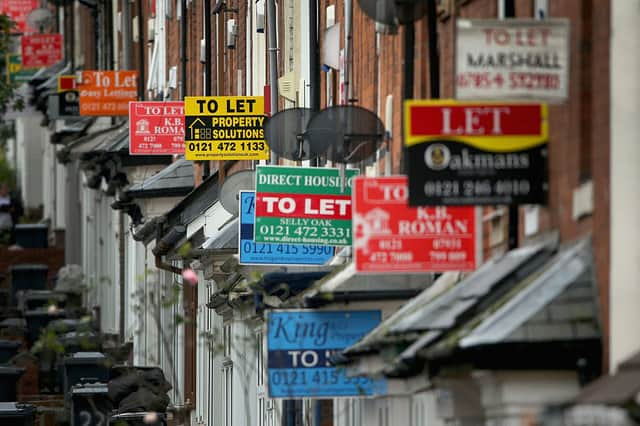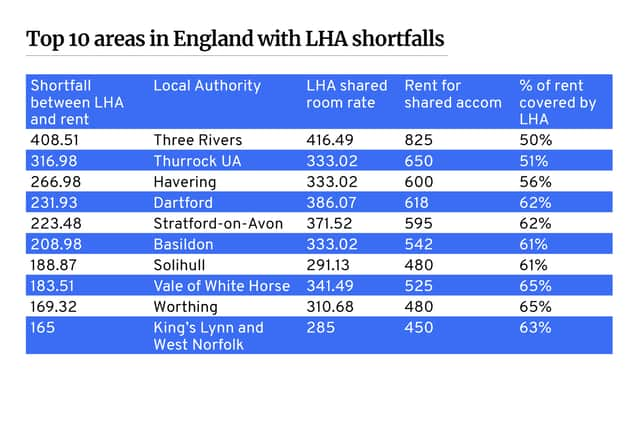Homelessness risk for young people as Universal Credit fails to cover cost of a room - most unaffordable areas revealed


Young people on Universal Credit are being placed at risk of homelessness because housing benefit does not cover the cost of renting a room in shared accommodation across most of England.
A leading homelessness charity has warned that many young people are trapped in a ‘permanent cost of living crisis’, with Local Housing Allowance (LHA) in some parts of the country covering just half the cost of renting a room in shared accommodation.
Does the Local Housing Allowance cover the cost of renting?
Advertisement
Hide AdAdvertisement
Hide AdNew analysis by Centrepoint has found that the LHA only covers the full cost of the cheapest privately rented shared accommodation in just one in eight local authorities in England, or 12% of those local authorities where rental data was available (231 of 312).
This means that in most parts of the country, the support on offer for young people in being able to find a home is insufficient, leaving the most vulnerable at risk of homelessness.
The lowest LHA rate, or the Shared Accommodation Rate, is intended to enable a single person with no dependables, claiming Universal Credit to rent a room in shared accommodation among the cheapest 30% of properties available in their local area.
The local rate is set centrally by the Valuation Office Agency and paid by the Department for Work and Pensions (DWP) as part of Universal Credit.
Advertisement
Hide AdAdvertisement
Hide AdCentrepoint matched Office for National Statistics (ONS) estimates on the cost of renting a room in each council area in England between October 2020 and September 2021 (the latest data) with the LHA rates for 2022/23 published by the DWP.
Loading....
While the grant should in theory cover the full cost of rent for shared properties within the bottom 30%, new analysis shows that across the country the average shortfall between the LHA and the cheapest 25% of properties was £70 per month, for those where rents outstripped the allowance.
There were 27 councils where LHA exceeded rents, mostly in London and the South East.
Balbir Chatrik, Centrepoint’s director of policy, said the LHA rates “must be urgently reviewed to ensure those already choosing between food and bills are not also facing homelessness too”.
Advertisement
Hide AdAdvertisement
Hide AdShe said: “The Local Housing Allowance is meant to make sure that the cheapest accommodation is accessible to those who need it.
“However, it has failed to keep pace with inflation and astronomical rents, making it even harder for young people to find affordable accommodation. This has trapped young people – who already lost more in the last Universal Credit cut than older claimants – in a permanent cost-of-living crisis.
In some local authorities the gap between the LHA rate and the average rental cost among the cheapest properties is hundreds of pounds.
In Three Rivers, in Hertfordshire, the average cost of renting a room in the 25% of cheapest shared accommodation is £825.
Advertisement
Hide AdAdvertisement
Hide AdHowever, the LHA rate is just £416.49, meaning a young person on Universal Credit would have to make up more than £400 every month, just to find a room in shared accommodation.
This analysis comes as the cost of renting rose by 2% in 2021, as reported by the ONS.


What should be done about this?
In response to the Covid-19 pandemic in 2020, LHA rates were meant to be restored to cover the average cost of rent among the the cheapest 30% of properties.
However, even then, just 16% per cent of local authorities’ LHA rates covered the true cost of renting, according to Centrepoint, and have since been refrozen.
Advertisement
Hide AdAdvertisement
Hide AdCllr David Renard, housing spokesperson for the Local Government Association, told NationalWorld that the best way to address this issue is by tackling “the unaffordability of housing, including the inappropriate LHA rates”, while also “empowering local authorities to build affordable housing”.
Renard says this was ‘partially addressed’ in the Coronavirus Act 2020, when the rates were increased, although the rate has remained frozen since then.
Renard said: “The confirmed freeze in the Autumn 2021 budget of LHA rates at 2020/21 levels is significant as while the cost of living is increasing, the freeze will leave even less money in the pockets of those on low-incomes.
“We want to see the end of this freeze, along with permanently restoring LHA rates to at least the cheapest third of private sector rents.
Advertisement
Hide AdAdvertisement
Hide AdA spokesperson for the tenants union Acorn, told NationalWorld that the Government should “unfreeze LHA” in the short term, but that it should look seriously at rent controls as part of a long term solution.
They said: “While LHA rates have been frozen since 2020 rents have continued to rise at the fastest rates in years, essentially meaning that people receiving housing benefit have less money to pay for more expensive housing.”
A DWP spokesperson said: “During the pandemic we increased Local Housing Allowance significantly and beyond inflation, benefitting over one million households by an average of over £600 over the year.
“We’re maintaining that boost, keeping support for private renters above pre-pandemic levels.”
Comment Guidelines
National World encourages reader discussion on our stories. User feedback, insights and back-and-forth exchanges add a rich layer of context to reporting. Please review our Community Guidelines before commenting.
